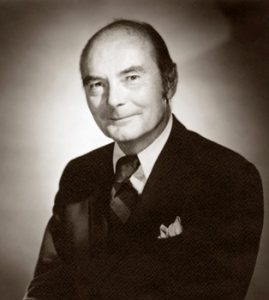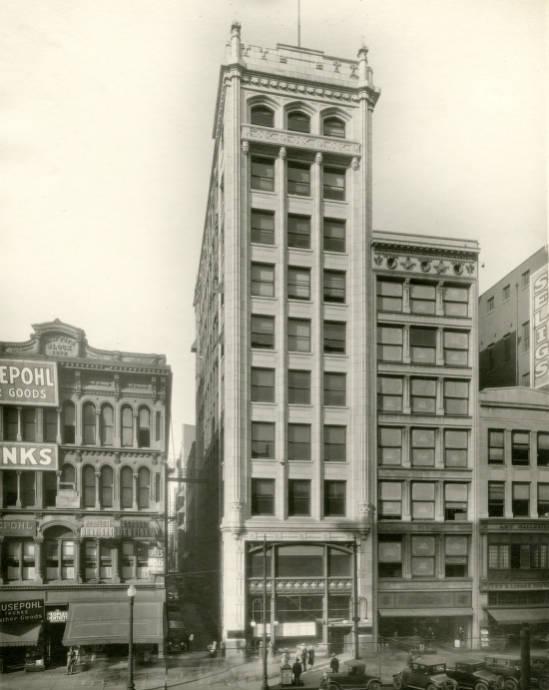
Photo info ...
Credit: Indiana Broadcast Pioneers View Source
(Mar. 27, 1912-Aug. 11, 2000). The grandson of Vice President , Richard M. Fairbanks was born in Indianapolis. His parents were Richard M. Fairbanks Sr. and Louise Bancroft Hibben Fairbanks. His mother died in September 1912, when Fairbanks was only five months old. Fairbanks Sr. left the upbringing of his son to his sister Adelaide Fairbanks (Timmons) Causey. Fairbanks attended for boys and then Philips Andover Academy in Andover, Massachusetts, and the Milford School, in Milford, Connecticut.
In 1931, Fairbanks followed in the footsteps of his father and grandfather to attend Yale University, but he left in January of his sophomore year. He returned to Indianapolis to marry Mary Evans Caperton, the daughter of Woods A. and Sue (Evans) Caperton. Her father was an executive at . The couple had two sons.
Fairbanks began working at the in 1932. Charles Warren Fairbanks and William Henry Smith (Fairbanks’ great uncle) had purchased the city’s afternoon paper from in 1892. By the time that World War II broke out, he had risen in the ranks to assistant managing editor.

During the conflict, Fairbanks was a lieutenant (junior grade) in the U.S. Navy. After serving in a variety of posts at Navy training schools, he finally became a public relations officer to Admiral Chester W. Nimitz, first in Pearl Harbor and then in Guam. Nimitz was commander in chief of the U.S. Pacific Fleet.
Upon his release from active military service, Fairbanks moved with his family to Miami, Florida, where he worked for the . Although he intended to stay in Miami, the was faltering. Feeling a responsibility to take an active role in the family business, Fairbanks returned to Indianapolis. He sought a way to save the and to find a new source of revenue. As more people turned to radio as a source of news and entertainment, buying a radio station seemed an effective way to do this. In May 1947, he convinced the board of directors to buy , then a 1,000-watt radio station that broadcast from the .
In 1948, Fairbanks negotiated the sale of the to owner of the , the competing morning newspaper. WIBC remained in Fairbanks’ hands as Pulliam already owned radio. At the time Federal Communications Commission (FCC) regulations did not permit any one entity to own more than one radio station in any given market. Fairbanks purchased the station’s license and set up a new company, WIBC, Inc., the forerunner of . He served as president and general manager, and the primary stakeholders in the company were other Fairbanks family members.
After creating WIBC, Inc., Fairbanks almost immediately expanded the station’s reach to cover Indiana, Illinois, and Kentucky. He established a strong newsroom and good programming and hired strong on-air personalities, such as , best-known as host of Pick-A-Pocket that aired from 1947 to 1968, and , who produced a popular daily radio essay My Town Indy and served as WIBC news director for 32 years.

In 1952, Fairbanks collaborated with and general manager to form the . Fairbanks entered the South Florida radio market in 1957 with the purchase of WRMF in the Cape Canaveral area, and after not winning the license for Channel 13 in Indianapolis, purchased Atlanta station WAII-TV in 1962.
Mary Evans Caperton died of cancer in 1967. After taking time off to care for her, Fairbanks returned to his business wanting to take complete control of WIBC, Inc. He sold WAII-TV, which at the time was its most lucrative asset, and used the proceeds to buy out the monetary interests of other family members in the company. Fairbanks became sole owner in August 1968, and the company name changed officially to Fairbanks Broadcasting. He remarried that same year. He also remarried, to Virginia Nicholson Brown, the granddaughter of Indianapolis author and journalist .
In 1968, Fairbanks brought James Hilliard to Indianapolis. He had worked for Fairbanks previously and became a part owner of Fairbanks Broadcasting. Hilliard relaunched WIBC-FM as the counterculture rock-and-roll station , a direct competitor to the dominant station that had begun broadcasting in 1963. WIBC-AM and WNAP-FM captured both adult and adolescent markets and drew half of all advertising dollars spent on radio to Fairbanks.
At its peak, Fairbanks Broadcasting owned 20 radio stations. These included WJNO-AM and –FM in West Palm, Beach, Florida, as well as WRMF, which led the company to dominate the radio market in the most populous region of South Florida.
In 1981, Fairbanks gave the WIBC building, located at 2835 N. Illinois Street, to for its student-run station , and the company headquarters moved to 9333 N. Meridian Street. Two years later, in 1983, Fairbanks began divesting. KVIL and WIBC/WNAP sold to John Blair & Company.
Fairbanks for many years had spent his winter months in Florida at the Ocean Reef Club in Destin, Florida. At the time that he sold WIBC/WNAP, he decided to make Florida his primary residence. He also moved his company to West Palm Beach, Florida. With this move, he changed its name to Fairbanks Communications.
In the early 1980s, Fairbanks diversified into cable television in Dearborn County in Indiana and in Delray Beach, Gulf Stream, and Palm Beach County, in Florida. He also set up a charter airplane division for Fairbanks, called Fairwind Aviation. Fairbanks sold his cable television holdings to Adelphia Communications Corporation in 1995. He came to a similar decision about the radio stations that the company continued to own. James Hilliard formed James Crystal Radio Group and bought the remaining Fairbanks Communications stations in 1997.
Fairbanks died in his home in Florida. He is buried in in Indianapolis. The , which he established in 1986, continues his legacy. It is focused on supporting institutions in the Indianapolis area.

Help improve this entry
Contribute information, offer corrections, suggest images.
You can also recommend new entries related to this topic.